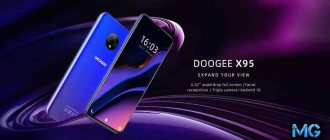Five best Xiaomi smartphones with high autonomy
I would like to immediately note that the duration of the phone’s operation does not directly depend on the battery capacity. A device with a 10,000 mA/h battery can work for 3 and 5 hours.
The essence lies in the operation scheme between the processor and other elements of the phone. Xiaomi with a 4,000 mA/h battery with certain components will last longer than a super autonomous phone from another company.
The TOP 5 rating is based not only on the numbers in the “capacity” column, but also on the resource intensity of the processor, display and software without an optimized energy consumption system.
OPPO A53 4/64GB
The fresh OPPO A53 received a 5000 mAh battery, but its main advantage is the display refresh rate of 90 Hz, which we still don’t see so often in the class of inexpensive smartphones.
The device received a 6.5-inch IPS matrix with a resolution of 1600×720 pixels, a new Qualcomm Snapdragon 460 chip, 4 GB of RAM and 64 GB of main memory, and a scanner on the rear panel.
What is not here is support for fast charging, as well as an NFC module.
- Screen diagonal / resolution: 6.5 inches / 1600×720
- Device weight: 186 g
- Processor: Qualcomm Snapdragon 460
- RAM / internal memory: 4 GB / 64 GB
- Battery capacity: 5000 mAh
- Camera resolution front / rear: 8 MP / 13/2/2 MP
- Memory card slot: yes
No. 1 in the ranking – Xiaomi Mi Max 2
At the moment, the Mi Max 2 model can be called not only the most autonomous in the line of Xiaomi phones, but also in comparison with other manufacturers.
Field testing of the GMSArena program showed that the device is third in the world in terms of battery life without additional recharging. Above it are only Lenovo P2 and GiOnee Marathon M5.
The phone has a 5310 mA/h battery and third-generation fast charging technology. The charging adapter is designed for 18V. In 30 minutes the device will charge from zero to 23%. It will take two and a half hours to charge 90%.
Daily phone use with one hour of surfing the Internet, an hour of calls and playing videos will last more than 5 days - 127 hours.
In addition, a 100% charge of the phone will ensure:
- 30.2 hours of active use of the 3G network;
- 19.5 hours of surfing the Internet;
- 21.4 hours of video playback;
Now such figures are considered a record. In addition to its high autonomy, Mi Max 2 has a good processor (Snapdragon No. 625) and 4 GB of RAM.
The phone cannot boast of high power, but for standard needs it will do just fine. The main feature of the phone is its screen, 6.44 inches diagonal with Full HD support.
Xiaomi Mi 9T Pro: the ideal version of Mi 9
- Release date: August 2019
- Weight: 191 grams
- Dimensions: 156.7 x 74.3 x 8.8 mm
- OS: Android 9
- Display diagonal: 6.39 inch
- Resolution: 1080 x 2340
- Chipset: Qualcomm Snapdragon 855
- RAM: 6/8 GB
- Permanent memory: 64/128/256 GB
- Battery: 4000 mAh
- Main camera: 48+8+13 MP
- Front camera: 20 MP
Price: 25,000 rubles
The design of this model contains moving elements. The front camera is located on a small pop-up platform, due to which the Mi 9T Pro was able to implement an ideal frameless screen.
Buyers choose Mi 9T Pro for its technical power, excellent battery life and presentable appearance. As for the shortcomings, I would like to note the lack of stereo sound and the poor location of the speaker - it is easy to cover it with your hand. However, most users will not even think of calling such features disadvantages. It’s much more serious that there are advertising blocks in system applications - such is MIUI, Xiaomi is not yet going to remove built-in advertising. Refusal to support microSD in a device in the mid-price segment is also a dubious decision.
Advantages:
- Premium design.
- Flagship-level characteristics.
- Non-standard design.
- Various memory configurations.
Flaws:
- Shell with advertising.
- There is no moisture protection.
- No stereo speaker.
- No memory card slot.
Buy
No. 2 in the ranking – Redmi Note 4
The model appeared in mid-17 and belongs to the middle category of mobile phones. Screen diagonal 5.5 inches with IPS matrix and Full HD support. Same processor as the previous model. The power indicators in Mi Max 2 and Redmi Note 4 are approximately similar.
Xiaomi Redmi Note 4 with 4,000 mA/h battery. The main drawback in terms of autonomy is the lack of fast charging technology, which makes you wait a long time for the battery to be fully charged.
Upon purchase, the user will receive a 5V/2A charger, which will charge the phone a quarter in half an hour; a full charge will have to wait almost 2.5 hours.
Field tests have shown that a minimal load on the phone (an hour of video, an hour of conversations and one hour of Internet use) will allow the phone to work for 120 hours, or almost five days. Exact indicators:
- 34.5 hours of active use of the 3G network;
- 17.5 hours of surfing the Internet;
- 15.4 hours of video playback;
In 2021, the phone can hardly be called relevant, but the model is ahead of many “state employees.” The phone has built-in dual-band WIFI and Bluetooth No. 4.2. It is unlikely that the user will be happy about the lack of NFC.
Additional Specifications
Due to its battery, Xiaomi Redmi 9 Power weighs 198 grams, and its body thickness is 10 mm or 162 mm high and 77 mm wide. It has a fingerprint scanner in the side power button, stereo speakers, an FM tuner, an infrared port (for controlling home appliances) and Bluetooth 5 and Wi-Fi 802.11ac (Wi-Fi 5) modules. Integrated receivers for satellite navigation systems - GPS, GLONASS, Beidou and Galileo.
From the factory, the new Xiaomi product comes with Android 10, released in August 2021, and it is not yet known when it will be updated to Android 11, which appeared a year later. The installed firmware is MIUI 12.
- The best rates for Dedicated dedicated servers on the Market.CNews IT marketplace
Elyas Qasmi
Share Short link
No. 4 in the ranking – Mi A2 Lite
The second name of the model is Redmi 6 Pro. The version is considered fresh, because it was updated for Android Van. The Mi A2 Lite lacks the proprietary MIUI graphical shell; the user receives pure Android No. 8.
The screen diagonal is 5.85 inches with a built-in IPS matrix. The phone supports Full HD+ resolution. The already familiar chip from Snapdragon – No. 625 – is responsible for good performance.
Display and processor
The Redmi 9 Power screen is built on an IPS matrix with a diagonal of 6.53 inches and a resolution of Full HD+ or 2340x1080 pixels. Protective glass Gorilla Glass 3 is installed on top of it, and the front camera is located in a teardrop-shaped cutout in the center of the top frame.
The thickness of the Redmi 9 Power screen frames is standard for budget smartphones
The smartphone display occupies 83.4% of the front panel. It has a peak brightness of 400 nits, a pixel density of 395 per inch, and an aspect ratio of 19.5%9.
Composite AI: what is it and why is it needed?
Artificial intelligence
Despite its low cost, the new Redmi 9 Power does not have a MediaTek or Unisoc processor - it has a Qualcomm Snapdragon 662. This is an 11-nanometer mobile chip with a built-in Adreno 610 graphics card.
The processor received eight computing cores, divided equally into two clusters. The first contains four Kryo 260 Gold with a frequency of 2 GHz, the second - Kryo 260 Silver at 1.8 GHz - high-performance and energy-efficient, respectively. There is no 5G support in this processor.
No. 5 in the ranking – Redmi 5 Plus
The Redmi 5 Plus model (perhaps the most commercially profitable of the entire list) closes the ranking of Xiaomi phones with a powerful battery. This line at one time gave a powerful impetus to the popularization of devices from the Middle Kingdom on the domestic market.
In 2021, you won’t be able to find a new Redmi 3 or Mi Max – the models have been discontinued and have been replaced by new phones. This does not apply to Redmi 5, the model is fresh and new.
The official release date is the end of February last year. The well-known Snapdragon No. 625 with a 6-inch screen is responsible for the technical part and balanced operation. There is support for Full HD +.
The battery capacity is 4,000 mA/h with second-generation fast charging. The box contains a 5V or 2 Ampere charger. Half an hour of charging will provide a charge of 30%.
This is a standard indicator for a budget mobile device. The standard operating scenario guarantees almost 4.5 days of continuous operation. Full capacity is sufficient:
- 23 hours of active use of the 3G network;
- 13.4 hours of surfing the Internet;
- 14.2 hours of video playback;
At the time of release, field tests showed that under average load the device will work for about forty hours. This was confirmed by reviews from device owners. This is a high figure for phones with modern hardware.
Xiaomi Mi 9: solid middling
- Release date: March 2019
- Weight: 173 grams
- Dimensions: 157.5 x 74.7 x 7.6 mm
- OS: Android 9
- Display diagonal: 6.39 inch
- Resolution: 1080 x 2340
- Chipset: Qualcomm Snapdragon 855
- RAM: 6/8 GB
- Permanent memory: 64/128 GB
- Battery: 3300 mAh
- Main camera: 48+12+16 MP
- Front camera: 20 MP
Price: from 21,000 rubles
Mi 9 is the best affordable Xiaomi smartphone with plenty of power.
Released at the beginning of 2021, it was among the first to receive the then advanced Snapdragon 855. Mi 9 is also one of the first mid-range smartphones with a triple camera and 48 MP resolution.
Two years have passed, and dozens of phones with similar characteristics have been released. However, Mi 9 differs from its competitors in that it has fewer weaknesses. The technical equipment is still up to date, the fingerprint scanner works quickly, and the camera is a real boon for a photographer, thanks to its high resolution and wide-angle lens.
Advantages:
- Good power reserve.
- Good camera.
- AMOLED screen.
- There is both fast and wireless charging.
Flaws:
- It gets very hot under load.
- Weak battery.
- No memory card slot.
- No optical stabilization.










